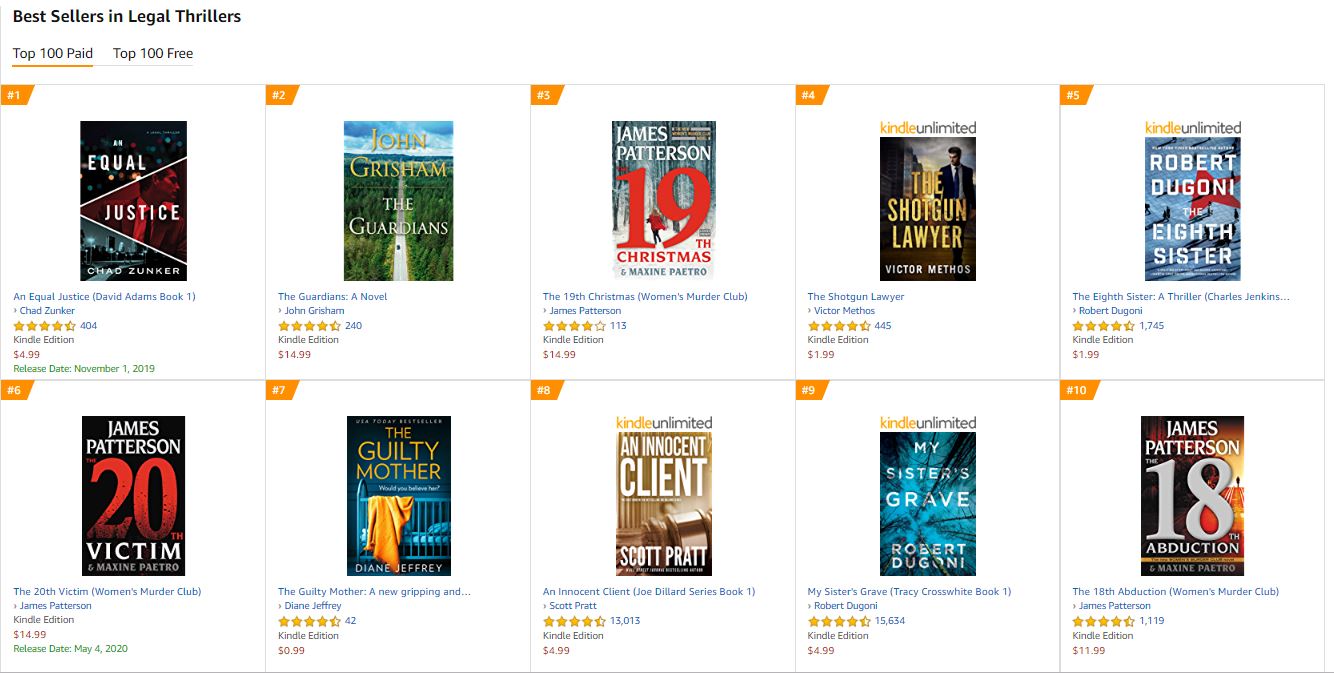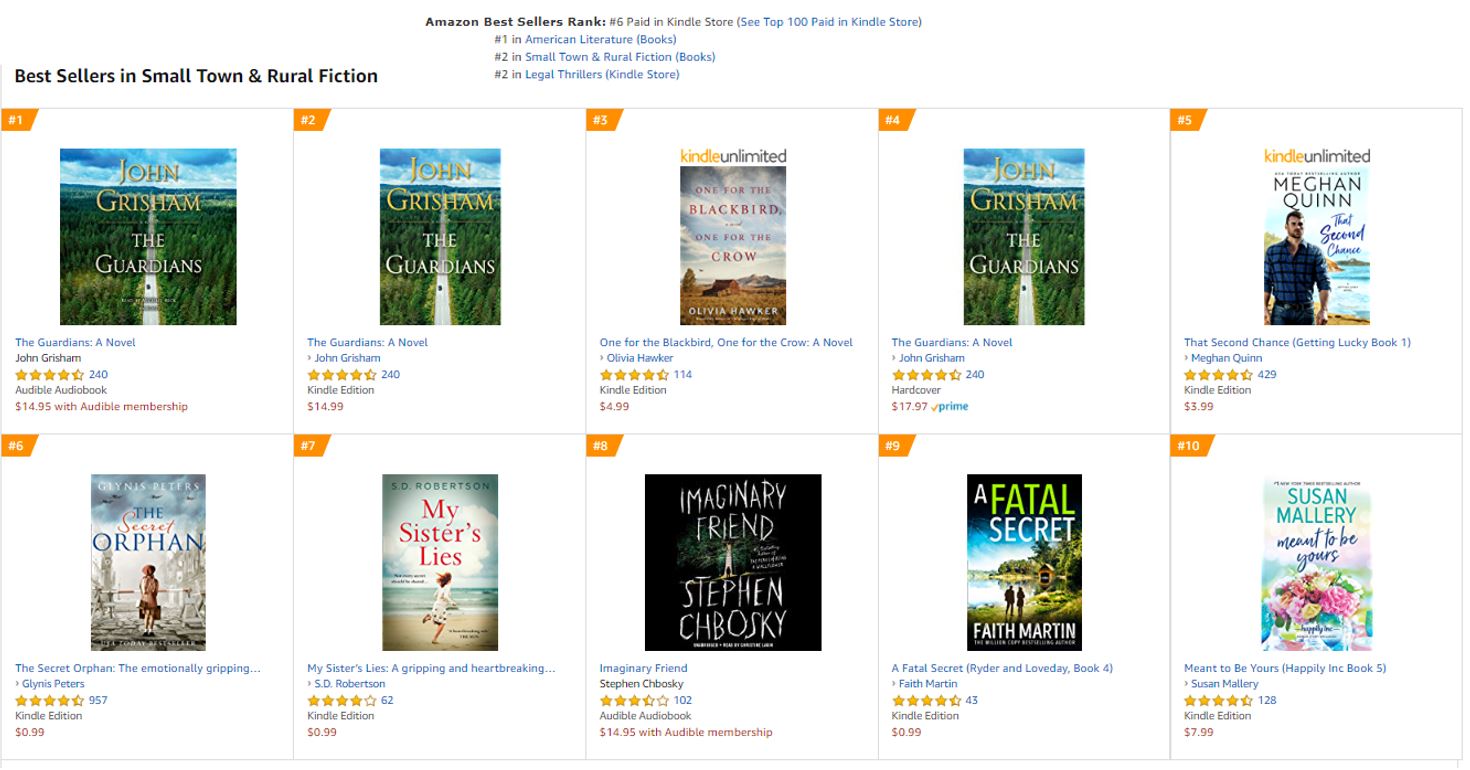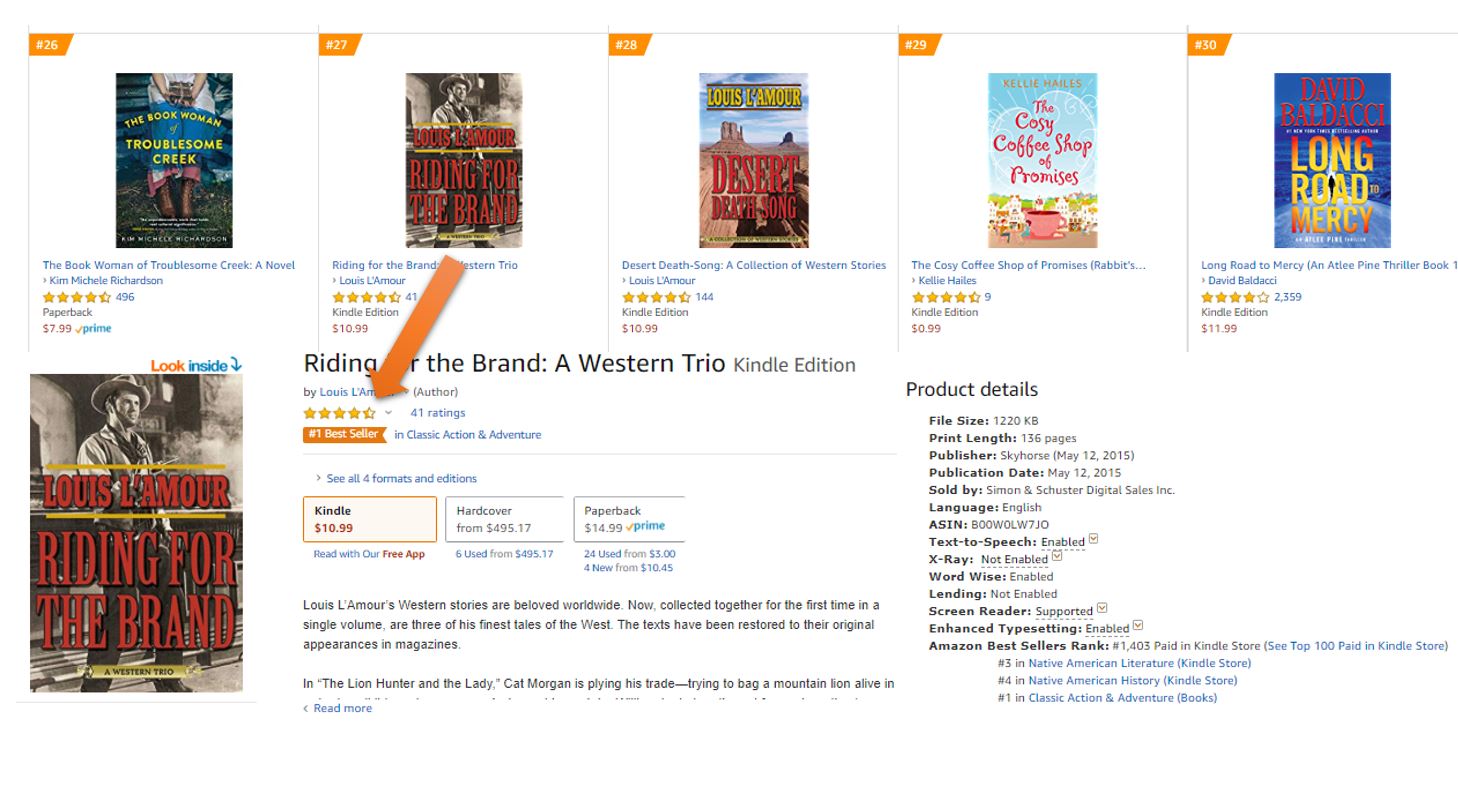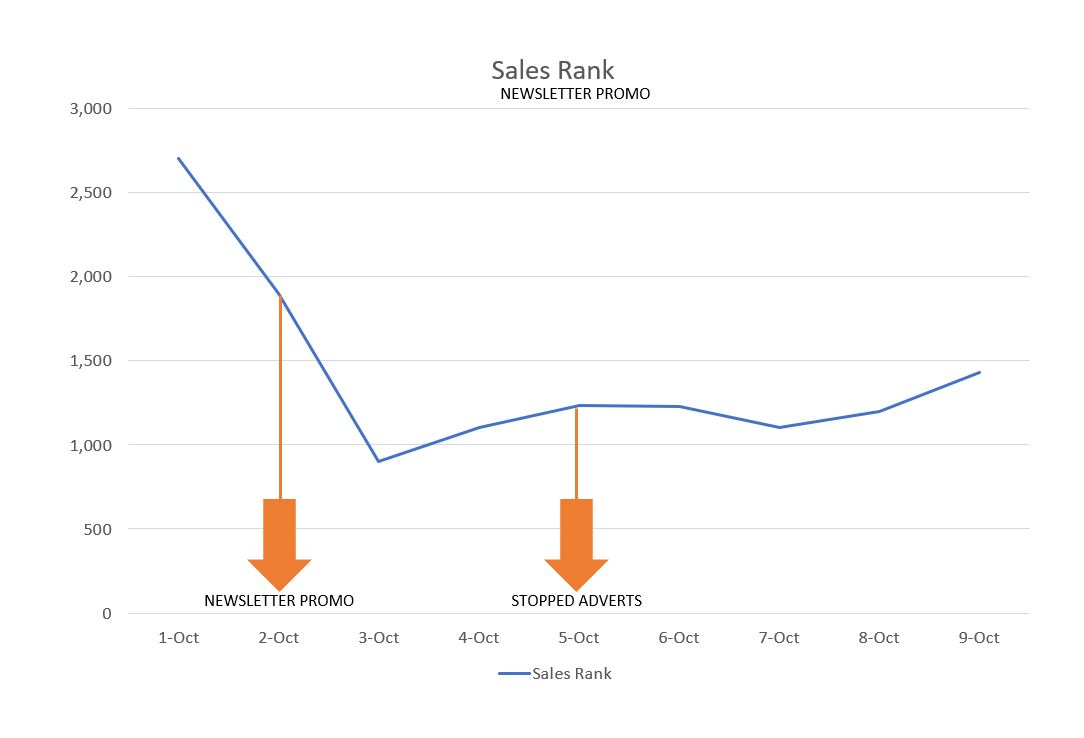Make Amazon’s Sales Rank Work for You
If you’re an author that ignores the Amazon Best Seller Rank (ABSR or Sales Rank) because you think it just exists to stroke the ego of successful authors or because you don’t think you have enough sales to ever get to the top, then it may be time to reconsider and start paying attention to it. Because even though only the #1 spot bestows a bestseller label to your book, just getting in the top 100 can be massively beneficial to your sales. Think of it as free promotion targeting all the readers that search for new books by browsing the top lists (which a great many do). The best part is that there isn’t just one bestseller, or one top list, but many of them – one for each genre and many sub-categories within those genres – which means that you don’t need thousands (or even hundreds) of sales a day to get on one! But to make it, you do need to pay attention to your sales rank, to what moves it, to which top list you have the best shot of ranking in, and to what promotions or ads help you get there. Then you can use that information strategically for each future book until you, too, are sitting on top of the charts. Unsure how to do that? Then read on!
I don’t know about you, but as a writer, I grew up longing to be featured on the NY Times Bestseller List, or have my book otherwise top the charts. Since hitting my stride as a self-published author, I’ve certainly seen my rank improve – but even when you hit the double-digits of the Amazon Best Seller Rank (ABSR) on Amazon, nothing but that #1 spot can secure you the all-powerful golden banner that declares your book a ‘bestseller.’
Likewise, your book can perform extraordinary well on Amazon’s charts, but if you’re part of KDP Select you’re not eligible for the sales ranks that hit the NY Times or USA Today, and brick-and-mortar sales can influence those, which are difficult for a self-published author to crack.
Nevertheless, ABSR is an incredibly powerful gauge for authors to get their head around; as not only does it offer a way to (eventually) reach a huge audience of potential customers, but it’s also a great way to keep track of your book’s progress and the effectiveness of any promotions or advertising you do.
What is Amazon Best Seller Rank (Sales Rank)?
There are over 2 million books for sale on Amazon’s Kindle platform, and more are published each and every day. Amazon keeps track of the number of these books that are sold – as they keep track of everything – and have a constantly monitored Sales Rank which calculates which books are the most popular and best-selling overall, within genres, and even within individual sub-categories.
For example, if you go to the Kindle Store landing page, you’ll see the Best Sellers in the Kindle Store presented as a Top 100 list – here are the Top 10 books as of today, according to the Amazon Best Seller Rank. Remember, the goal of this ranking is to get to be #1, or as close as you can get – which means that the lower your sales rank is, the better.

Now, it’s important to note that Amazon doesn’t generate this ranking based entirely on individual book sales – although that is a significant (the significant) deciding factor. Amazon themselves describe their process for calculating the ABSR as being “based on customer activity – sales and borrows – of your book relative to the activity of other books.”
The fact that borrows through Kindle Unlimited are taken into effect is huge. Most genre authors – myself included – can see upwards of 50% of their sales come from being part of KDP Select; so while exclusivity to Amazon bars you from being included in the best-seller lists of the New York Times or USA Today lists at all, that same exclusivity can help you rise within Amazon’s own internal Sales Rank chart.
So, basically, your ABSR is calculated on a nearly-hourly basis by Amazon comparing the popularity of books against each other, and determining the top dogs. It’s a constantly shifting dynamic, and every time you visit the Kindle Landing page, you’re likely to see different titles up there on the Top 100 list. To be listed as #99 on the Amazon Best Seller Rank, your book has to be performing better at that moment than all but the 98 books that rank more highly than yours do.
What is the benefit of a high Sales Rank?
When it comes to being a New York Times best-seller, or featured in the USA Today charts, you get bragging rights (not to mention those inclusions being great (if shortlived) advertisements.)
However, in the Amazon ecosystem, a low Sales Rank (remember, lower is better) can be even more beneficial to your sales.
The most obvious benefit is getting your book featured in the Top 100 list. If you can get your book into the Top 100 paid books on Amazon, you’ll be front and center for everybody coming to visit the Kindle Store homepage; and simply by virtue of having your book featured so prominently, you’ll find your Product Page getting a lot of extra clicks (and hopefully purchases.)
It’s such a powerful way to drive sales that a lot of authors will invest hundreds or thousands of dollars of advertising to get onto the Top 100 list, just in the hopes that when they do, their book will hit the ‘tipping point’ at which it’s so visible to all the traffic on the Kindle Store homepage that people will click ‘buy now’ and there’ll be an explosion of sales. To a large extent, this is exactly what happens; and why hitting a heavy launch is such a powerful strategy towards generating successful sales.
But ABSR doesn’t have relevance only on the Kindle Store landing page; and nor is it limited to general book sales. Each genre and many sub-categories of that genre also have their own Top 100 lists – and this is where the magic happens, from a book sales perspective.
To get onto the overall Top 100 list for Amazon isn’t easy – it requires the combined efforts of effective and hard-hitting promotions, paired with a book that people are just dying to click ‘buy now’ on. I’ve written nearly 30 full-length novels in my time, and only one has ever arrived at a sub-100 ABSR with a minimum of promotion tied to it. Other times, I’ve had to work hard to get there; and paid for it through advertising heavily on Facebook and through newsletter promotions.
Now, ostensibly being in the Top 100 of all books on Amazon is great – but look at the examples I posted above. In amidst genre fiction by Michael Connelly and John Grisham, you have literary fiction by Olivia Hawker and Barbara O’Neal. While all these books are clearly performing gangbusters in the sales department, they’re not being sold to the same audience. If you’re a fan of thrillers and horrors, only a fraction of the Top 100 books on Amazon will appeal to you; and that’s why the number of customers who shop using Amazon’s Top 100 books page is extremely limited.
Instead, readers tend to browse new books by clicking past that homepage to view the Top 100 books of their favorite genre.
For example, John Grisham and Chad Zunker both have books listed in the overall Top 100 – but if you click on those books and go to their product pages, you’ll see that the books do much better on the Top 100 category for Kindle eBooks < Mystery, Thriller & Suspense < Thrillers < Legal

The advantage of being featured on the Top 100 list for Thrillers < Legal is two-fold. For a start, it takes a much smaller number of sales to be featured in this Top 100 list. This means it’s a much more manageable goal to get into this Top 100 list, as opposed to the general list (and will cost a significant amount less to achieve through paid advertising.)
Secondly, and more importantly, the readers browsing the Top 100 legal thrillers on Amazon are almost certainly interested in buying and reading legal thrillers; whereas the general Top 100 list on Amazon encompasses fiction and non-fiction, thrillers and romance, sci-fi and more. If a reader has taken the time to click onto the Top 100 list specifically for Thrillers < Legal there’s a good chance they’re actually looking to buy a book in that category; whereas the general Top 100 list might contain a large number of books that are irrelevant to individual readers.
In fact, one of the less-well-known traits of fiction readers on Amazon is that they search for new books to read specifically within the category section of the Kindle Store – and because Amazon has a whopping 16,000 individual book categories (from the all-encompassing ‘fiction’ to incredibly specific examples like ‘Jewish American Fiction’) it’s actually surprisingly easy to dominate individual categories and earn a #1 Bestseller banner without having sold a gazillion books.
Take this example. In addition to being #2 in Thrillers < Legal, you’ll find John Grisham’s new book The Guardians ranked as #1 in the Small Town & Rural Fiction category.

What’s remarkable here is that The Guardian’s isn’t just #1 in this category (in Audiobook format) but also #2 and #4! And while The Guardian has a #6 ABSR score (meaning it’s the 6th best-selling book overall on Amazon today) Susan Mallery’s Meant to be Yours has an ABSR of #502, and yet still secures the #10 spot in this category.
At #27 in Small Town & Rural Fiction in Louis L’Amour’s Riding for the Brand – which is itself the #1 best seller in the Classic Action & Adventure fiction. Given that Louis L’Amour died in 1988 (I remember, because I used to devour his books) that’s pretty damned impressive.
But this isn’t because of Louis L’Amour’s spectral marketing genius reaching from beyond the grave. It’s because the ABSR to get the #1 spot for Classic Action & Adventure is significantly lower than achieving the #1 spot in a more popular genre, or the Kindle Store Top 100 as a whole. (Today, you only need an ABSR of #1403 to get the top spot in that category!)
If you use any of the Sales Rank calculators available online – which are inexact, because they don’t take into account KU borrows – you’ll see that John Grisham’s The Guardian achieves its ABSR score of #6 with an estimated 2,700 paid sales per day. Louis L’Amour’s bestseller ranks #1,403 on Amazon, but to get that you need a mere 72 sales per day (which is still a lot – but is still less than 3% of the sales John Grisham is getting.)

Let’s go along to a really obscure genre – not that there’s any reason for it to be obscure, but simply because it’s not the sort of genre that most people grab a paperback from on the way through the airport: LGBT Literary Criticism.
The #1 Best Seller in this category – complete with the #1 Best Seller badge – is Daemon Voices by Philip Pullman – which has an ABSR of #47,918. That equates to just 3 paid sales (or KU borrows) per day. Most self-published authors have comfortably remained in the lower ranks than that – and yet few have a #1 Best Seller to their name!

So, this just demonstrates how massively important it is to pay attention to both category and Sales Rank in terms of marketing and promotion – because if your book fits into a suitably obscure genre, you too could have a #1 Best Seller! More importantly, though, if you can get listed in the Top 100 for a not-totally-obscure category, your ABSR could score you a highly visible place that will earn you a ton of free promotion.
What can your ABSR do for you?
Okay, so we’ve outlined what the Amazon Best Seller Rank, or Sales Rank is – and how it can make your book more visible on Amazon. But how can you use this information to help form your marketing strategy?
Well, there are a number of things this information could be useful to you for:
- It can help you become more visible in less-competitive categories – if you trawl the lesser-known categories of Amazon’s Kindle Store, you’ll be able to identify ones in which you can make a serious play at hitting the Top 100 without going broke to do so. Tracking the Sales Rank of the top-performing books in that category can give you an idea of where you need to be in order to find your book featured there; and if you can get into the rankings of any category, it’ll positively impact your sales (relatively speaking – clearly being a #1 Best Seller in LGBT Literary fiction isn’t shifting a gazillion books for Phillip Pullman.) Of course, to take advantage of that it helps to know what sort of ranks your book typically achieve with your current marketing strategies so you know if you have the possibility of hitting the top spot in a category.
- It can help you see the effectiveness of your promotional activities – there are various ways to track the effectiveness of your promotions and advertising; the most obvious of them being book sales. However, unless you’re using Advertising on Amazon, there’s a broken link between the clicks you’ll get on Facebook, Twitter and other advertising platforms and how many of those clicks translate into sales and borrows through Kindle Unlimited. While you can follow trends through Book Report or other sales tracking solutions, keeping an eye on your Sales Rank can give you a different perspective on the impact your promotions are having; and the value they provide beyond sales (for example, in how highly your book ranks in various categories as a result.)
- It can earn you a #1 Best Seller badge – If you’ve spent any time studying self-publishing on the Internet, you’ll have been bombarded with ads promising to “help you publish a best seller” – and this is often how they do it. They’ll help you identify an obscure category and bombard your advertising long enough to get to the Number #1 spot in that category… and that’s it. While I’d argue that the coveted #1 Best Seller badge isn’t all it’s cracked up to be – it can be a lovely thing to have in your author blurb, and it certainly won’t hurt your sales. Keeping track of your ABSR and contextualizing it within relevant categories can be your way to achieve this coveted goal.
How can you use your ABSR?
With the KDP Dashboard and other associated tools like Book Report, you can keep track of your daily sales and your sales history. And while you can view your historical daily sales rank by logging into Author Central – click Sales Info, select Sales Rank, then search for your book (you may need to change your pen name as well) – that has limited usefulness when not paired with data on what may have caused the various spikes in the chart that you see. Unfortunately there’s no way to add any of those sorts of notes or annotations to author central, but that doesn’t mean you can’t do it other ways – and you may find it worth the effort. Here’s how I do it.
- Pick a consistent time of day – I like 5pm, because it takes into account all the day’s sales activities (or lack of them), but you may want to track it more than once a day, especially when you are running more than one promotion at a time (always a good idea to stack them) and want to more finely track when certain ones start
- Then, each day at that time (or times), go to your book and log your ABSR rank
- Then, log them in a spreadsheet along with labels of when you ran your promotions. It’s helpful to turn them into a chart – kind of like this:

As you can see, I’ve used Google Sheets to create this, and added flags to mark particular events – like when I ran a promo, or started or ended an advertising campaign. This allows me to objectively track what the impact of these marketing and promotions might be on my sales rank (and thus, my overall sales).
While this is a little labor-intensive, I think it has a lot of value. Back when I wrote about the importance of tracking your daily word count, I quoted Peter Drucker, who wrote: “You can’t improve what you can’t measure.”
Tracking your daily word count, your sales rank, your sales and borrows (if you’re enrolled in KDP Select), and your income – and looking at all of them holistically, especially in the context of any marketing or promotion you’ve done – will allow you to see patterns and trends you might have not been aware of otherwise.
This mindset can be the difference between making it or breaking it as an author – because the facts can dictate your focus and priorities. A lot of would-be authors don’t track data this way and gauge the success or failure of their marketing and promotions on their perception of how successful they are. Perception is inaccurate, though – and cold, hard, inarguable data like this can help you not just calculate the real value and impact of your advertising and marketing (so that you can improve with each book, spending more time and money on what works and less on what doesn’t), but also help you keep track of the (hopeful) improvement in your writing career as a whole.
Another article I recently wrote spoke about a survey about what made the difference between authors earning $10,000 a year and those earning $100,000 – and it wasn’t rocket science. Authors earning the most money wrote the most, they spent money on specific marketing tactics, and they followed a process. Identifying the process – working out what works – is what makes all the difference between your writing being a hobby, and being a lifestyle.
The secret to being a successful writer is to identify the process and stick to it. Tracking your Sales Rank – and what impacts it – is one of the most important ways in which you can do this.












A couple of things: Amazon tracks your book ranking for you daily, and the charts are accessible through your Author Central account.
Log into Author Central. Under the Sales Info tab, click on Sales Rank. That will pull up a list of your books and their current rank. If you click on the small graph image next to the book cover, the graph with your ranking history comes up. It defaults to a one month history, but you can change it to different timeframes.
Also, just to clarify – Kindle Unlimited page reads do NOT count towards your rank. When the book is BORROWED in KU, that borrow is counted as being equivalent to a paid sale for ranking purposes, whether the person reads the book or not. You get paid for pages read, but they don’t do anything for your sales rank.
Hi Lauren – thanks for the comment, you’re absolutely right. I’d forgotten that Author Central tracks daily sales rank as I (like many authors, I suspect) rarely log in to AC and it’s hidden behind a few steps. But now that you’ve refreshed my memory, I’ve updated the blog with the steps to find it.
And I also agree that we weren’t clear in the point that it is the borrow itself from KU that affects rank, not the actual page reads, so I’ve clarified that as well. Thanks again!
Thank you for this informative post.
I have a question about this suggestion in the post:
“each day, go to your book and log your ABSR rank.”
I have read — I don’t know if it is true — that each time a book’s page is accessed without resulting in a sale, Amazon algorithms downgrade the book’s discoverability.
If this is true, then checking the sales ranking of a book every day could hurt its sales.
Do you have any information or insight about this?
No, I don’t believe there to be any truth to that, nor have I seen any credible evidence by anyone proving that. I would guess it is simply a rumor.